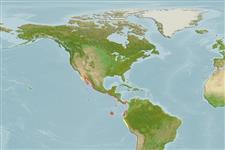Environment: milieu / climate zone / depth range / distribution range
Ecologia
marino associati a barriera corallina; distribuzione batimetrica 21 - 40 m (Ref. 5222). Subtropical; 33°N - 13°S, 118°W - 76°W (Ref. 5222)
Eastern Pacific: southern California, USA to Peru, including Revillagigedo and Galapagos Islands, Cocos Island, Clipperton Island.
Size / Peso / Age
Maturity: Lm ? range ? - ? cm
Max length : 100.0 cm TL maschio/sesso non determinato; (Ref. 5222); peso massimo pubblicato: 12.5 kg (Ref. 4699)
Short description
Chiavi di identificazione | Morfologia | Morfometria
Spine dorsali (totale) : 11; Raggi dorsali molli (totale) : 18 - 20; Spine anali: 3; Raggi anali molli: 9. Distinguished by the following characteristics: body depth, 2.1-2.5 in SL; dorsal profile of head is steep; eye diameter less than snout length, 5.2-8.0 in HL; short pectoral fins, length 18-26% of SL; rounded caudal fin; smooth scales, mostly covered by skin; lateral line scales 62-67 (Ref. 089707).
A diurnal predator that feeds on small benthic fishes and occasionally on crustaceans. Often it uses browsing herbivorous fishes as a moving blind in order to feed on the cryptic fauna disturbed by these browsers; it will also follow foraging moray eels to catch the fishes frightened from their hiding places. Small juveniles have been seen hiding among the long spines of the dark-colored sea urchin, Centrostephanus coronatus.
Life cycle and mating behavior
Maturities | Riproduzione | Spawnings | Egg(s) | Fecundities | Larve
Heemstra, P.C. and J.E. Randall, 1993. FAO Species Catalogue. Vol. 16. Groupers of the world (family Serranidae, subfamily Epinephelinae). An annotated and illustrated catalogue of the grouper, rockcod, hind, coral grouper and lyretail species known to date. Rome: FAO. FAO Fish. Synop. 125(16):382 p. (Ref. 5222)
IUCN Red List Status (Ref. 130435)
Threat to humans
Harmless
Human uses
Pesca: scarso interesse commerciale; Pesce da pesca sportiva: si
Strumenti
Special reports
Download XML
Fonti Internet
Estimates based on models
Preferred temperature (Ref.
123201): 23 - 26.3, mean 24.6 °C (based on 7 cells).
Phylogenetic diversity index (Ref.
82804): PD
50 = 0.6250 [Uniqueness, from 0.5 = low to 2.0 = high].
Bayesian length-weight: a=0.01148 (0.00558 - 0.02364), b=3.04 (2.88 - 3.20), in cm total length, based on LWR estimates for this (Sub)family-body shape (Ref.
93245).
Trophic level (Ref.
69278): 4.5 ±0.80 se; based on food items.
Resilienza (Ref.
120179): Molto basso, tempo minimo di raddoppiamento della popolazione più di 14 anni (Preliminary K or Fecundity.).
Fishing Vulnerability (Ref.
59153): High vulnerability (60 of 100).
Nutrients (Ref.
124155): Calcium = 13.4 [7.5, 27.8] mg/100g; Iron = 0.458 [0.229, 0.802] mg/100g; Protein = 19.5 [17.6, 21.1] %; Omega3 = 0.193 [0.111, 0.339] g/100g; Selenium = 16.7 [7.6, 35.5] μg/100g; VitaminA = 71.9 [22.3, 259.5] μg/100g; Zinc = 0.509 [0.328, 0.786] mg/100g (wet weight);
